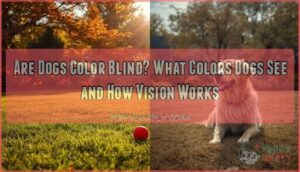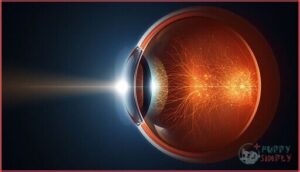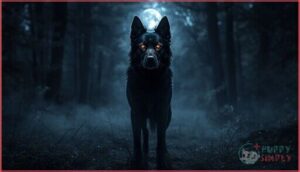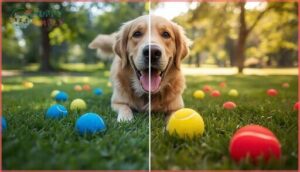This site is supported by our readers. We may earn a commission, at no cost to you, if you purchase through links.
You’ve probably tossed a bright red ball across your yard, wondering why your dog seems to lose track of it the moment it lands on green grass. The culprit isn’t your dog’s attention span—it’s their vision. Dogs don’t see the world in the rich rainbow humans enjoy, but they’re not stumbling through life in black and white either.
Their eyes contain two types of color-detecting cones instead of our three, creating a visual experience dominated by blues and yellows while reds and greens blur into muddy browns and grays. This dichromatic vision isn’t a flaw—it’s an evolutionary adaptation that traded some color discrimination for enhanced motion detection and night vision.
Understanding exactly what your dog sees can transform how you choose toys, set up training sessions, and create an environment where your companion can thrive visually.
Table Of Contents
- Key Takeaways
- Dog Color Vision Basics
- Are Dogs Color Blind
- Colors Dogs Can See
- Dog Eye Structure Explained
- Night Vision in Dogs
- Practical Implications for Owners
- Debunking Color Blindness Myths
- Dog Vision and Behavior
- Frequently Asked Questions (FAQs)
- What is the easiest color for a dog to see?
- What is the hardest color a dog can see?
- What colors can dogs see in grass?
- How does a dog see a tennis ball?
- Do all dog breeds see colors differently?
- Can dogs see TV screens and colors clearly?
- How does age affect dog color vision?
- Do puppies see colors like adult dogs?
- Can colorblind dogs be trained for service work?
- Can dogs see in complete darkness?
- Conclusion
Key Takeaways
- Dogs have dichromatic vision with two cone types instead of three, allowing them to see blues and yellows vividly while reds and greens appear as muddy browns or grays—similar to human red-green color blindness.
- Their visual system evolved to prioritize motion detection and superior night vision over color discrimination, with rod-dominated retinas and a reflective tapetum lucidum that amplifies available light by roughly tenfold in low-light conditions.
- Choosing blue or yellow toys and training tools instead of red or orange significantly improves your dog’s ability to locate and track objects, since these colors provide maximum contrast within their limited color spectrum.
- Dogs compensate for restricted color vision through exceptional olfactory and auditory capabilities, detecting scents at concentrations 10,000 times lower than humans and hearing frequencies up to 60,000 Hz for effective environmental navigation.
Dog Color Vision Basics
Your dog’s world looks different than yours, and understanding that difference starts with the basics of canine color vision. The key lies in how their eyes are built—specifically, the types of color-detecting cells they’ve compared to what you’ve got.
Let’s break down how your dog sees color and what that actually means for the way they experience their surroundings.
Dog Vision Compared to Humans
Your dog’s visual world differs fundamentally from yours in color perception and visual acuity. While you navigate life with trichromatic vision, your dog relies on dichromatic vision—a simplified color palette that prioritizes survival over aesthetics.
Key differences in dog vision compared to humans:
- Visual acuity: Dogs see at 20/75, meaning objects clear to you at 75 feet appear sharp to them only at 20 feet
- Color perception: Your million-color spectrum reduces to roughly 10,000 distinguishable hues in canine eyes
- Motion detection: Dogs excel at spotting movement, compensating for reduced detail recognition
- Low light advantage: Enhanced rod density gives dogs advanced night vision capabilities
- Eye structure: Dichromatic vision stems from having two cone types instead of your three
Despite dog color blindness limitations, their visual system evolved perfectly for dawn and dusk hunting. The dog’s eye anatomy, including the tapetum lucidum function, plays a key role in their unique visual abilities.
Types of Color-Detecting Cones
To understand what your dog sees, you need to know about cone cell biology and photoreceptor function in the canine retina. While your trichromatic eyes contain three cone types detecting red, green, and blue wavelengths, your dog’s dichromatic vision relies on just two.
Their retinal structure includes short-wavelength-sensitive cones peaking around 429 nanometers (blue-violet) and medium/long-wavelength-sensitive cones peaking near 555 nanometers (yellow-green). This simplified cone arrangement doesn’t mean dogs are colorblind—it means their color perception operates on a fundamentally different spectrum than yours.
Understanding dog color vision is essential for effective communication and interaction with your pet.
Colors Perceived by Dogs
Your dog’s dichromatic visual system creates a world painted primarily in blues and yellows. When you toss that bright red ball onto green grass, your dog sees brownish-gray against more brownish-gray—not ideal for canine sight or visual acuity.
Blue spectrum wavelengths appear vivid and distinct, while yellows remain easily distinguishable. This limited color perception doesn’t mean total dog color blindness; rather, it reflects reduced color discrimination across wavelengths outside their blue-yellow range.
Are Dogs Color Blind
The term “color blind” can mislead you in relation to your dog’s vision. Your pet isn’t moving through a black-and-white world—they’ve dichromatic vision, meaning they possess two types of color-detecting cones rather than your three. This gives them functional color perception, just a narrower palette.
Think of it like human red-green color blindness: your dog’s canine optics compress reds and greens into muddy browns or grays, while blues and yellows remain vivid and distinct. Scientific studies using behavioral tests confirm this color recognition pattern.
Dogs see like humans with red-green color blindness—reds and greens turn muddy while blues and yellows stay vivid
So yes, dogs are technically colorblind by human standards, but they’re definitely not seeing in grayscale. Their visual acuity simply works differently than yours.
Colors Dogs Can See
Now that you understand dogs have dichromatic vision, you’re probably wondering what this actually looks like through their eyes.
Dogs clearly see blues and yellows, but reds and greens present a different story altogether. Let’s break down exactly which colors your dog can distinguish and which ones blur together into muddy browns and grays.
Blue and Yellow Color Spectrum
Your dog’s dichromatic vision privileges blue and yellow wavelengths with striking clarity. Two cone types in the canine visual cortex create this blue-yellow dominance, enabling your pet to distinguish navy from sky blue and multiple yellow shades effortlessly.
This spectrum sensitivity produces striking visual acuity within their limited color perception range—blues and yellows appear vivid and contrasting, while other hues compress into grayish or brownish tones that lack definition.
Perception of Red and Green
Your dog’s dichromatic vision creates red-green color blindness identical to human deuteranopia—that bright red ball on your lawn? It appears as a muddy yellowish-brown or grayish tone, offering minimal color contrast against the grass.
Green visibility collapses similarly, rendering both hues as muted variants along a yellow-to-brown axis. This red perception limitation means your dog detects these objects primarily through brightness differences and motion rather than color salience, fundamentally restricting their ability to distinguish what you see as vibrant, separate colors.
Color Combinations Visible to Dogs
Blue-yellow contrast defines the sharpest visual distinction within your dog’s dichromatic vision, creating functional color perception where red-green combinations collapse into indistinguishable hues. While canine spectrums compress human color categories into a two-dimensional axis, strategic pairings enhance visual acuity and object salience during training and play.
Consider these evidence-based color combinations for maximum canine color perception:
Blue toys against yellow-brown grass—wavelengths around 429 nanometers contrast strongly with 555-nanometer backgrounds, enhancing fetch visibility
Yellow training equipment on blue surfaces—occupies opposite ends of the dichromatic vision axis
Blue-and-white combinations—produces sharp chromatic separation your dog distinguishes easily
Yellow markers with neutral gray—prevents the color confusion that plagues red-green object identification
Understanding dog color vision and blindness transforms how you select toys, training aids, and environmental markers.
Dog Eye Structure Explained
To understand why dogs see the world the way they do, you need to look at the structure of their eyes. The canine retina contains specialized cells that determine what colors your dog can perceive and how well they navigate in different lighting conditions.
Let’s examine the key anatomical features that shape your dog’s unique visual experience.
Rods and Cones in Canine Retina
Think of your dog’s retina as a cellular mosaic where rods and cones work in concert, each with a specialized job. Rod dominance is striking—these photoreceptors outnumber cones by roughly 20:1, even in the area centralis where visual acuity peaks.
This retinal structure prioritizes motion detection and low-light performance over vibrant color vision. The cone subtypes present—S-cones sensitive to blue wavelengths and L/M-cones tuned to yellow-green—give dogs their dichromatic color vision, fundamentally different from your trichromatic perspective.
Photoreceptor density directly shapes what canine vision delivers: remarkable dim-light sensitivity, but limited color discrimination.
Tapetum Lucidum and Night Vision
Your dog’s eyes glow in the dark thanks to the tapetum lucidum—a reflective layer beneath the retina that acts like a biological mirror. This reflective layer bounces incoming photons back through rod photoreceptors, amplifying available light by roughly tenfold and dramatically enhancing night vision.
The tapetum function explains why canine senses excel in scotopic vision: your dog’s low light adaptation turns twilight hunting grounds into clearly navigable terrain, giving them visual perception that outperforms yours when darkness falls.
Anatomical Differences From Humans
Your dog’s visual system diverges sharply from yours in retinal structure and eye morphology. While you possess a fovea—a densely packed cone region delivering razor-sharp central vision—dogs rely on an area centralis with roughly 23,000 cones per square millimeter, about one-fifth your central cone density.
This fundamental difference in photoreceptor density means your visual pathways prioritize fine detail and rich color vision, whereas canine senses evolved for motion tracking. Dogs also lack your degree of binocular vision overlap, trading depth perception for wider peripheral scanning.
Their visual perception system reflects ancestral hunting demands: outstanding low-light performance and movement detection trump the color-rich, high-resolution world you experience through your uniquely human eye anatomy.
Night Vision in Dogs
While dogs may see fewer colors than you do, they make up for it with exceptional night vision capabilities. Their eyes have evolved with specialized adaptations that allow them to navigate and hunt effectively in low-light conditions. Understanding these adaptations reveals why your dog moves so confidently during evening walks or in dimly lit rooms.
Low-Light Vision Adaptation
When light fades, your dog’s visual system shifts into a striking scotopic vision mode that takes about 30 minutes of dark adaptation to reach full sensitivity. This waiting period allows rod-dominated photoreceptors to chemically reset, boosting rod sensitivity to detect photons that would otherwise go unnoticed. Once adapted, canine vision operates effectively in environments five times dimmer than what you’d find comfortable.
Here’s what happens during low-light adaptation:
- Pupil dilation maximizes light entry through enlarged apertures
- Rod photoreceptor activation replaces cone-based daylight processing
- Visual performance enhancement improves motion detection despite reduced low light acuity
- Chemical sensitivity adjustment increases photon capture efficiency across the retina
Your dog trades spatial resolution for detection capability—seeing blurrier images but moving confidently where you’d stumble.
Reflective Membrane and Rods
Behind your dog’s retina lies a specialized mirror-like membrane called the tapetum lucidum, which sits between the photoreceptor layer and the choroid. This structure contains 18–20 reflective layers of crystalline rodlets that bounce unabsorbed photons back through the retina—fundamentally giving photoreceptors a second chance to capture light.
Combined with rod density reaching 501,000 cells per square millimeter in the area centralis, this biological retroreflector enhances scotopic vision dramatically. The tapetum’s reflective layers achieve roughly 75% reflectance, amplifying low light sensitivity and enabling canine vision to function in conditions five times dimmer than what you’d tolerate comfortably.
| Anatomical Feature | Functional Impact |
|---|---|
| Tapetum Lucidum | Reflects ~75% of light back through retina for second photon capture |
| High Rod Density | 501,000 rods/mm² in central retina optimize dim-light detection |
| 18–20 Reflective Layers | Create substantial light amplification supporting enhanced scotopic vision |
Improved Navigation and Hunting
Your dog’s rod-dominated retina and light-amplifying tapetum work together to create impressive advantages for terrain navigation and hunting during crepuscular hours. Motion detection becomes the primary tracking tool—those fleeting movements of prey trigger rapid visual responses even when color cues fade. In field conditions around 10–100 lux, your dog’s visual acuity enables effective object localization despite limited canine color perception. Low light transforms from handicap to advantage, allowing successful navigation through complex environments where human vision falters.
Consider how this evolutionary design facilitates five key hunting advantages:
- Detecting small, fast prey movements at distances exceeding your own detection range
- Maintaining visual contact with fleeing targets through dense vegetation
- Distinguishing blue and yellow markers against vegetated terrain during dawn retrievals
- Tracking motion-based environmental cues when color perception and blindness limit chromatic information
- Integrating dim-light vision with acute olfaction for multisensory prey location strategies
This biological architecture explains why working gundogs excel during twilight hours—their visual system prioritizes the motion and contrast essential for successful marks over the full-spectrum color vision you possess.
Practical Implications for Owners
Understanding how your dog sees color isn’t just an interesting fact—it can actually change how you interact with them day to day. Simple adjustments to the toys you buy and the training tools you use can make a real difference in how well your dog responds and engages.
Let’s look at a few practical ways to work with your dog’s unique vision rather than against it.
Choosing Toys and Training Tools
Your dog’s dichromatic vision directly influences how you’ll boost training success and play engagement. Strategic toy and training aid selections work with—rather than against—canine color perception, transforming visual cues into reliable signals your dog processes effortlessly.
Research with 134 free-ranging dogs demonstrated statistically significant color preferences for yellow objects over alternatives. When you choose blue balls for outdoor fetch or yellow platforms for agility courses, you’re aligning training aids with your dog’s natural visual strengths. Indoor environments benefit from dark blue toys against light flooring, while textured surfaces paired with best colors boost tactile engagement. Color-coded systems—blue for “stay” stations, yellow for “go” zones—reduce confusion and accelerate learning. You’ll notice improved retrieval rates and sustained canine engagement when toys match your dog’s effective color range, directly supporting dog behavior and training outcomes through vision-informed selection.
| Item Type | Best Colors | Visual Benefit |
|---|---|---|
| Fetch toys | Blue, yellow | High contrast against grass |
| Agility markers | Blue or yellow cones | Clear spatial boundaries |
| Training discs | Bright yellow | Improved ground visibility |
| Tug ropes | Blue fabric | Strong shape definition |
Avoiding Red and Orange Colors
Because dogs exhibit dichromatic vision resembling red–green color blindness, you’ll want to eliminate red and orange training tools and toys from your routine. These hues blend into grass, carpet, and outdoor terrain, reducing color contrast and visual cues your dog needs for quick object detection. Studies confirm that canine safety improves when you avoid relying on colors dogs perceive as muddy yellows or browns:
- Red toys disappear against green lawns
- Orange markers fail to provide clear boundaries
- Both colors reduce training effectiveness
- Colorblind-friendly alternatives improve dog color vision outcomes
Choosing dichromatic-compatible options strengthens your dog’s engagement and performance.
Using Blue and Yellow for Visibility
Choosing training tools and toys in blue or yellow isn’t just helpful—it’s grounded in how canine perception actually works. Because dogs see clearly in blues and yellows, these colors provide strong visual cues your dog can track during fetch, agility runs, and boundary training.
Studies confirm that blue markers stand out against grass and sand, improving safety visibility outdoors. When you select toys within your dog’s functional color perception range, you’re working with their dichromatic vision rather than against it.
This color contrast advantage helps colorblind dogs spot moving objects faster, making playtime more rewarding and training sessions more effective for dog color vision and blindness challenges.
Debunking Color Blindness Myths
You’ve probably heard people say that dogs see only in black and white, or that they’re completely colorblind. These ideas have been floating around for decades, but they don’t match up with what we actually know from vision research.
Let’s clear up some of these persistent myths about canine color perception.
Common Misconceptions About Dog Vision
You’ve probably heard that dogs see only in black and white—a persistent vision myth that science has thoroughly debunked. Dogs actually possess dichromatic vision with two cone types, allowing them to perceive blues and yellows clearly, much like humans with red–green color blindness.
This canine sight isn’t total colorblindness; it’s selective color perception. Your dog struggles distinguishing reds and greens, which appear brownish or gray, but navigates a genuinely colored world.
Understanding this dichromatic vision helps with dog eye care choices, from selecting high-visibility toys to appreciating how visual acuity differences shape your companion’s experience.
Spectrum Challenges in Dogs
Think of your dog’s color spectrum as a compressed rainbow—dichromatic vision collapses the familiar red-orange-yellow-green sequence into muted browns and grays.
Here’s what this means for canine optics:
- Redgreen color blindness prevents discrimination between mid-to-long wavelengths, with peak cone sensitivity around 555 nm
- Visual acuity measures four to eight times poorer than yours
- Spectrum limitations reduce brightness precision by roughly half
Color perception relies heavily on blue-yellow contrasts to compensate.
Busting Myths With Science
For decades, the myth that dogs see only in black and white persisted—despite zero solid evidence backing it up. Modern vision research has changed everything.
Behavioral studies using modified color plates designed for human red-green color blindness show your dog consistently chooses chromatic targets over grayscale ones, even when brightness cues are stripped away. Electroretinography confirms two cone types with peak sensitivities at 429 and 555 nanometers, proving dichromatic vision isn’t guesswork—it’s measurable physiology.
Dogs trained to select specific wavelengths perform above chance, demonstrating functional color perception in everyday tasks. Science debunks the old narrative cleanly: your dog’s canine insights into color may be limited compared to yours, but they’re real, testable, and far from the monochrome myth that won’t quit.
Dog Vision and Behavior
Your dog’s limited color vision doesn’t hold them back—they’ve adapted beautifully by leaning heavily on their other senses. Understanding how vision influences behavior helps you interpret what your dog needs and how they experience the world around them.
Let’s look at the key ways dogs compensate for their visual limitations and what this means for their daily lives.
Compensating With Smell and Hearing
Your dog’s world operates through sensory integration that goes far beyond what you might imagine. While dichromatic vision limits color perception, dogs excel through multisensory navigation—their olfactory cues detect molecules at concentrations 10,000 times lower than you can perceive, and auditory compensation extends their hearing to 60,000 Hz.
This environmental adaptation transforms how canine senses and perception work together:
- Olfactory epithelium surface area up to 20 times larger than yours allows tracking across hundreds of meters
- Brain activation in olfactory bulbs and amygdala processes smell-based social recognition instantly
- Sound localization accuracy averaging 7.6 degrees guides orientation when visual cues fade
- Wind direction and humidity monitoring optimizes scent dispersal for navigation
- Ultrasonic frequency detection alerts to environmental signals you’ll never hear
Research shows functional MRI activation confirms dogs prioritize smell for building environmental maps. When you understand these compensatory sensory systems, you’ll recognize why your colorblind companion navigates confidently through spaces where limited chromatic vision would otherwise create challenges.
Interpreting Behavior and Meeting Needs
While your dog’s multisensory toolkit compensates for dichromatic vision, their visual frustration becomes apparent when color perception in dogs creates environmental challenges. When you notice repeated failed retrieves or avoidance behaviors during play, you’re witnessing how poor color contrast affects canine behavior and vision directly.
Recognizing these patterns enhances better canine enrichment and training effectiveness:
| Behavior Signal | Visual Cause | Solution Strategy |
|---|---|---|
| Repeated searching failures | Red/green toys blend with grass | Switch to blue or yellow items |
| Increased handler-directed gaze | Low-contrast markers confuse orientation | Use high-contrast visual cues |
| Displacement behaviors (sniffing, scratching) | Task expectations unmet visually | Combine sensory stimulation modalities |
| Disengagement from activities | Visual crowding elevates stress | Simplify color palettes in training spaces |
Understanding canine color perception transforms how you interpret hesitation and meet their sensory needs.
Importance of Ethical Breeding and Environment
Beyond meeting your dog’s immediate sensory needs, breeding ethics and early environment shape visual processing and behavioral health for life. Genetic diversity in responsible breeding programs reduces inherited disease variants—the top 20% of prevalent variants account for 98% of detected risks.
When breeders prioritize low-stress housing and structured socialization, puppies develop stronger stress resilience and fewer fear-based behaviors. In contrast, dogs from high-volume facilities often show persistent anxiety and learning deficits that compound their dichromatic vision challenges.
Environmental enrichment during critical developmental windows fosters neurological maturation, helping your dog integrate colorblind visual information with other canine senses more effectively. Responsible ownership begins with understanding how breeding ethics and early experiences fundamentally influence dog behavior and canine welfare throughout their lives.
Frequently Asked Questions (FAQs)
What is the easiest color for a dog to see?
Your dog’s dichromatic vision is dominated by two wavelengths: short (blue) and medium (yellow). Blue provides the strongest chromatic contrast against most natural backgrounds, making it the easiest color for canine sight to detect reliably.
What is the hardest color a dog can see?
Red presents the greatest challenge for your dog’s dichromatic vision. Without long-wavelength cones, red objects appear as murky browns or grays, basically vanishing against grass or soil—particularly frustrating during fetch games.
What colors can dogs see in grass?
In grassy environments, your dog’s dichromatic vision transforms green blades into brownish-gray tones. They perceive yellows clearly—like sunlit patches—and detect blue sky contrasts, but grass visibility remains limited due to their unique canine color perception and optical health adaptations.
How does a dog see a tennis ball?
That fluorescent sphere practically glows in your dog’s visual world. Thanks to dichromatic color perception, the yellow tennis ball pops vividly against the grass’s dull beige tones.
Their enhanced motion detection tracks every bounce with precision.
Do all dog breeds see colors differently?
All dog breeds share the same dichromatic color vision—two cone types detecting blue and yellow wavelengths.
Breed vision variance in dogs doesn’t affect color perception; it’s a species-wide trait, not breed-specific.
Can dogs see TV screens and colors clearly?
Modern televisions with refresh rates above 100 Hz exceed dogs’ flicker fusion threshold, allowing smooth motion perception.
Your dog perceives blue and yellow screen elements vividly, while reds appear brownish due to dichromatic color vision limitations.
How does age affect dog color vision?
As your dog enters senior years—usually around age seven, the aging retina experiences measurable functional decline. Nuclear sclerosis clouds the lens, muting blue-yellow color perception, while conditions like progressive retinal atrophy progressively impair both cone-mediated color vision and overall visual acuity in older companions.
Do puppies see colors like adult dogs?
Your puppy’s color perception stages develop gradually through retinal cone formation. By eight weeks, their canine visual maturation reaches adult dichromatic vision, allowing full blue-yellow color vision like mature dogs—marking complete vision maturity timeline.
Can colorblind dogs be trained for service work?
Yes, dichromatic vision doesn’t prevent service dog tasks. Your dog’s blue-yellow perception aids navigation, mobility assistance, and medical alerting because training emphasizes verbal cues, scent detection, and spatial awareness rather than red-green color discrimination for successful task performance.
Can dogs see in complete darkness?
No—unlike night-vision goggles, your dog’s eyes need at least minimal ambient light to form images. Their low light vision outperforms ours through rod dominance and the tapetum lucidum, but complete darkness renders canine senses entirely dependent on smell and hearing for nighttime navigation.
Conclusion
Think of your dog’s vision as a finely tuned instrument—what it lacks in color range, it gains in motion tracking and twilight clarity.
Now that you understand are dogs color blind and what colors can they see, you can make intentional choices: swap that red fetch toy for blue, use yellow markers in training, and stop wondering why your companion sometimes overlooks what seems obvious.
Their world isn’t broken—just different.
















